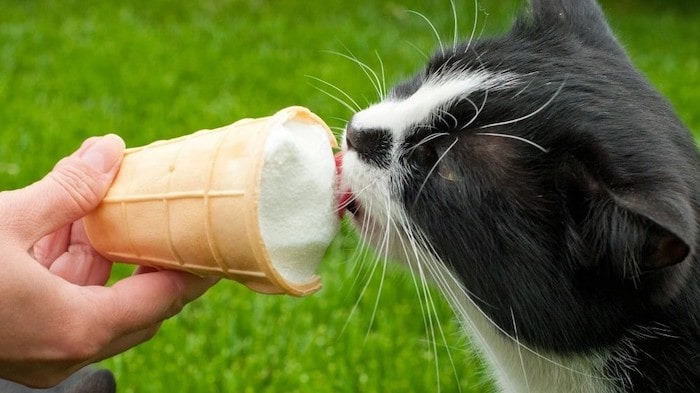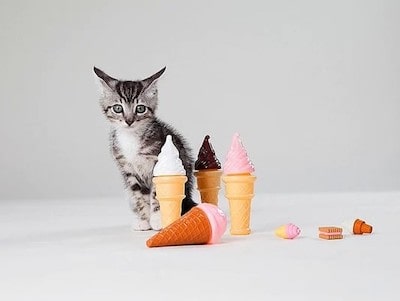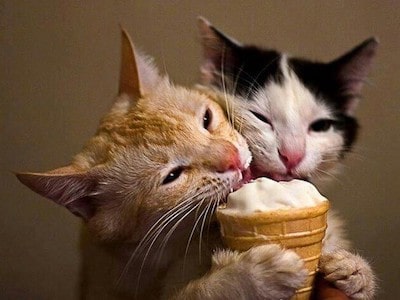Can cats eat ice cream? It’s a question that often arises when we see our furry feline friends casting longing glances at our frozen treats. After all, who wouldn’t want to share a delicious scoop of ice cream with their beloved cat?
But before you give in to those pleading eyes, it’s important to understand the potential risks and considerations involved.

In this article, we’ll delve into the topic of cats and ice cream, exploring whether it’s safe for our whiskered companions to indulge in this frozen delight.
So, let’s separate fact from fiction and discover the truth about cats and their relationship with ice cream.
Why Ice Cream is Not a Good Choice for Cats
Ice cream is mainly made of cream, sugar, and flavorings, none of which are beneficial for cats. In fact, they can cause various health problems for your kitty, such as:
- Lactose intolerance: Cats are lactose intolerant, meaning they cannot digest the milk sugar in ice cream. This can cause digestive issues like gas, stomach aches, and diarrhea. Some cats may be more sensitive than others, but it’s best to avoid dairy products altogether for your cat’s comfort and well-being.
- Obesity and diabetes: Ice cream is high in fat and calories, which can lead to obesity and diabetes in cats. Obesity can also increase the risk of heart disease, arthritis, and other health problems in cats. Cats don’t need extra sugar in their diet, as they get enough energy from their protein-rich food.

- Toxicity: Some ice cream flavors can be toxic to cats, such as chocolate, coffee, raisins, or anything containing artificial sweeteners like xylitol. These ingredients can cause vomiting, seizures, liver failure, or even death in cats. Even if the ice cream is plain vanilla, it may still contain additives or preservatives that are harmful to cats.
How Much Ice Cream Can a Cat Eat?
The safest answer is none. Ice cream has no nutritional value for cats and can only cause harm to their health. However, if you really want to give your cat a taste of ice cream, make sure it is plain vanilla and only let your cat have a few licks.
Vanilla is the least harmful flavor for cats, as long as it does not contain any toxic additives.The amount of ice cream a cat can eat depends on their size and tolerance.

Nutritionists recommend that average-size breeds like Siamese and Persians should not have more than one teaspoon of ice cream at a time. Larger breeds like Ragdolls or Maine Coons can have up to two teaspoons.
Always monitor your cat’s reaction after giving them ice cream. If they show any signs of discomfort or distress, stop feeding them ice cream and contact your veterinarian.
Risks and Benefits of Ice Cream for Cats
Ice cream is a delicious dessert that can bring joy and satisfaction to both humans and cats.
However, ice cream can also cause some health problems for cats, depending on the type, amount, and frequency of consumption.
Here are some of the potential risks and benefits of ice cream for cats:
| Risks | Benefits |
| Cats may have difficulty digesting lactose in ice cream | A small amount of ice cream can provide extra hydration |
| Ice cream contains lactose, which many cats cannot tolerate | The cold temperature of ice cream can soothe inflamed gums |
| Ice cream is high in calories and can contribute to obesity | Ice cream can be a special treat that brings joy to cats |
| Ice cream lacks essential nutrients cats need for a balanced diet | The occasional spoonful can serve as a source of pleasure |
| Cats may have allergic reactions to ingredients in ice cream | Ice cream can be a source of bonding and shared experiences |
What are Some Alternatives to Ice Cream for Cats?
Instead of ice cream, you can offer your cat some healthier and more appropriate treats that they will enjoy. Some examples are:
- Frozen cat food or treats: You can freeze some wet cat food or specially made cat treats in an ice cube tray and give them to your cat as a cool snack. Make sure the food or treats are suitable for freezing and thawing. This way, you can provide your cat with something tasty and nutritious that will also help them stay hydrated.
- Non-dairy ice cream: You can find some non-dairy ice creams that use nut milks, soy milk, or oat milk instead of cream. These are generally safe for cats as long as they do not contain any toxic ingredients. However, they are still high in calories and sugar, so only give them to your cat in very small amounts.
- Frozen yogurt. Frozen yogurt is similar to ice cream but made with yogurt cultures instead of cream. It may be easier for some cats to digest than ice cream, but it still contains lactose and sugar. Unless it is labeled as lactose-free, frozen yogurt is not a good option for cats.
- Homemade popsicles. You can make your own popsicles for your cat using water, broth, or pureed fruit. Avoid adding any sugar, salt, or artificial flavors. You can use silicone molds or paper cups to freeze the mixture and insert a stick or a toy for your cat to hold on to.
FAQ
Can cats eat any type of ice cream?
Cats should not consume ice cream that contains ingredients toxic to them, such as chocolate, artificial sweeteners (e.g., xylitol), or flavors like coffee or raisins. Stick to plain vanilla or other cat-friendly flavors without any harmful additives.
How much ice cream can I give my cat?
It’s generally recommended not to give ice cream to cats, as it lacks essential nutrients and can lead to health issues. If you decide to offer a small taste as an occasional treat, make sure it’s a very small amount and monitor your cat for any adverse reactions.
Are there any cat-safe frozen desserts available in pet stores?
Yes, there are frozen treats specifically designed for cats available in some pet stores. These treats are formulated with ingredients that are safe and appropriate for feline consumption. Always read the labels and consult with your veterinarian before purchasing any treats for your cat.
How can I keep my cat cool during hot weather without ice cream?
Provide fresh water at all times, keep the environment cool with fans or air conditioning, provide shaded areas, and consider using cooling mats or frozen water bottles wrapped in towels for your cat to lie on. You can also consult with your veterinarian for additional tips on keeping your cat cool and comfortable in hot weather.
Conclusion
While it may be tempting to share a tasty treat like ice cream with your feline companion, it’s important to consider the risks and potential harm it can pose to their health.
Cats are lactose intolerant, and the high sugar and calorie content in ice cream can lead to digestive upset, weight gain, and other health issues.
While a small taste of plain vanilla ice cream on rare occasions may not be immediately harmful, it’s best to avoid giving ice cream to your cat altogether.
Instead, focus on providing a balanced and appropriate diet that meets your cat’s nutritional needs.
There are alternative frozen treats and cat-friendly options available that can still bring joy and refreshment to your furry friend without compromising their health.
Always consult with a veterinarian for guidance on suitable treats and feeding practices for your cat.

Charlene Pare is the founder of Cat Likes Best. She manages and strategizes the content published on this website. When she isn’t working, she enjoys exploring the city around with her Ameican Shorthair kitty–Moli. Being a technocrat and an avid cat lover, she also writes on pet tech products and some of the featured articles.




